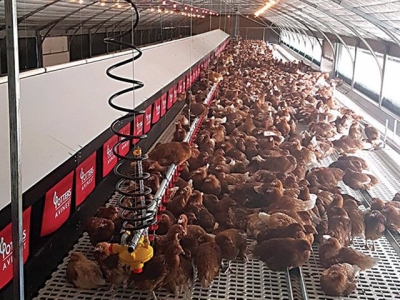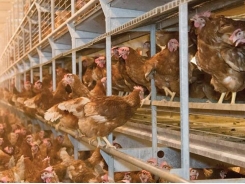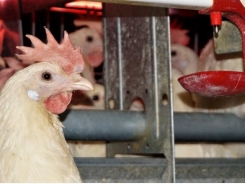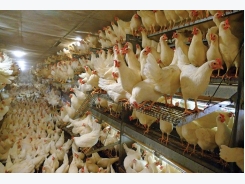8 considerations for cage-free laying hen nutrition

Cage-free hens face greater disease challenges, so producers must emphasize gut health and immune system support. | Courtesy Potters Poultry
Egg producers must account for more than just housing when changing production practices
The cage-free layer is subject to less controlled conditions and — particularly in the case of free-range — is exposed to a variety of weather conditions. Energy levels in the diet will therefore be a key consideration to make sure that nutrients are not diverted from egg production. Similarly, any increase in hen feed intake needs to be balanced with protein levels to avoid unwanted increases in egg size.
Outside of a cage, hens are in greater contact with their feces and, if allowed outside, the number of disease challenges can increase. This creates a need for increased gut health and immune support. With any cage-free system there is greater opportunity for bird interaction, which can lead to an increase in vices; therefore, fiber provision is a key consideration.
This article explores several feeding and production practices to enhance the health and performance of a cage-free flock.
Cage-free considerations
Beyond the housing investments, cage-free layers require alterations to their feeding programs. Here are eight considerations producers and nutritionists need to keep in mind:
1) Energy balance
For the reasons above the energy requirements of cage-free layers are greater than those kept in cages. Laying hens can compensate for this by eating more to achieve the energy level they need for both maintenance and egg production. The level of this increase, depends on both housing system and country of production and can vary by as much as 30 to 40 grams per bird per day between summer and winter.
2) Controlling egg size
Knowing what egg sizes your market requires and trying to meet it is paramount for all producers. However, in the case of cage-free layers it can be harder to achieve. Higher feed intakes mean hens are consuming more protein, which will increase egg size. Therefore, protein, amino acid and energy levels need to be carefully balanced.
Hen body weight also influences egg size. Up to peak lay it is important to regularly weigh them, to know if they are meeting breed targets. The nutritional density of the diet fed can then be increased or decreased accordingly. Similarly, to control egg size diet changes can be moved or specifications adapted. Nutrition companies should work closely with egg producers to capture and monitor production parameters including, body weight, egg number, egg weight, feed intake, to formulate diets accordingly.
3) Trace elements
As egg production is assumed to be the same, irrespective of housing system, vitamin and mineral requirements will also be. As cage-free hens have higher feed intakes, it can be argued that levels of calcium and phosphorus could be reduced. However, many free-range egg producers provide supplementary calcium in the form of oyster shell, as an enrichment, as well as supporting egg quality. Ensuring good feather cover is also an important objective.
4) More on fiber
It is understood that poultry have an inherent need for fiber, which is even more important to address for laying hens kept in a cage-free environment. Layer chicks are better able to utilize high-fiber feed ingredients than broiler chicks. Similarly, older birds can tolerate higher levels of fiber in the diet than young ones. Consistent benefits have been achieved using a lignocellulose type fiber additive. Appropriate fiber provision is also known to improve the digestibility of certain nutrients.
Physical structure of the feed is key to stimulate gut physiology and maintain gut health. The diet should supply a mixture of dietary fiber to help the bird find a digestive balance. This will help hens maintain an optimum gut microbiota, as well as helping to prevent vices such as feather pecking. A higher fiber diets increases the time birds spend eating, satiating their need to peck and reducing time available for negative bird interactions. Beak tipping appears to be less necessary in caged hens. Different countries have different regulations regarding beak tipping and are banned in some. Therefore, other ways to control injurious pecking in cage-free housing are required.
5) Gut health and immunity
Cage-free layers face a greater challenge in terms of gut health, as they are more in contact with the manure. Bacteria, protozoa and worms all have more opportunity to infect birds. Supporting gut health by nutritional means is therefore even more important, as well as good management and biosecurity.
Improvements in intestinal health can help to help reduce the effect of these disease challenges. As well as suitable fiber provision, probiotics are prebiotics have given good results in free-range hens. Essential oils and medium chain fatty acids are also used. Theses nutritional strategies become even more interesting as the market looks to reduce the use of antibiotics.
6) Pullet rearing
When rearing hens for cage-free systems many different management techniques are employed — including training birds to move between levels. But there are also many nutritional considerations. Robustness and uniformity are important for all pullets but particularly so for those destined for a cage-free system. Making sure the diets are high enough in protein to ensure good growth during the rearing phase is essential. Calcium is also important to ensure good bone strength — especially in the keel and legs — and can sustain the increased mobility required in an aviary environment.
Due to increased exposure to pathogens and potential disease vectors pullets destined for free-range housing receive more vaccinations. Some producers will as electrolytes, vitamins and minerals to the water at these times — to support their immune systems at this time and reduce stress. Again, ensuring target weights are met will prevent setbacks and mean that when transferred to the laying house they are in the best possible condition. As opposed to a cage environment, the birds will need to learn where the feed, water and nest boxes are.
7) Breed considerations
In many cases the breeds used in caged and cage-free systems will be the same – with differences down to country or company preferences. Brown egg layers are more popular in Western European markets and are often associated with free range. Whilst white egg layers are more common in regions where hens are caged, they can also be kept successfully in cage-free systems.
Brown hens are bigger birds, with greater maintenance requirements and poorer feed conversion than white birds. Several breed companies are now offering breeds specifically developed for free-range systems, focusing on robustness and suitable behavioral traits.
8) Environmental variability
One of the main differences between caged and cage-free housing systems for laying hens is the variability in environmental conditions. The extent to which external temperatures are of influence will depend on ventilation and heating provision in the house. Free-range birds also must contend with changing weather conditions. Colder temperatures increase the bird’s maintenance requirements for energy, whilst high temperatures can reduce feed intakes. Therefore, the country and area of production will influence hen’s dietary requirements.
In conclusion
Nutritional guidelines are available for each breed, with specifications linked to feed intakes. It is therefore important to know what the hens are eating on a particular farm to tailor the diet accordingly. These can form the basis of the hen’s diet; with further amendments related to specific housing systems, egg markets or climatic conditions. Specific management guides for keeping cage-free hens are also produced by genetic companies.
With cage-free production there is much greater variability, dependent on many environmental factors. Producers need to get to know their houses and flocks — working closely with feed companies to tailor nutritional specifications. As for all laying hens, production data should be monitored closely, to change diets at the optimal time. In this way cage-free production can be optimized, egg size controlled, and egg quality ensured.
Related news
Tools

Phối trộn thức ăn chăn nuôi

Pha dung dịch thủy canh

Định mức cho tôm ăn

Phối trộn phân bón NPK

Xác định tỷ lệ tôm sống

Chuyển đổi đơn vị phân bón

Xác định công suất sục khí

Chuyển đổi đơn vị tôm

Tính diện tích nhà kính

Tính thể tích ao




 Study shows feed efficiency gains in Canadian egg…
Study shows feed efficiency gains in Canadian egg…  5 questions about cage-free hen health, welfare
5 questions about cage-free hen health, welfare